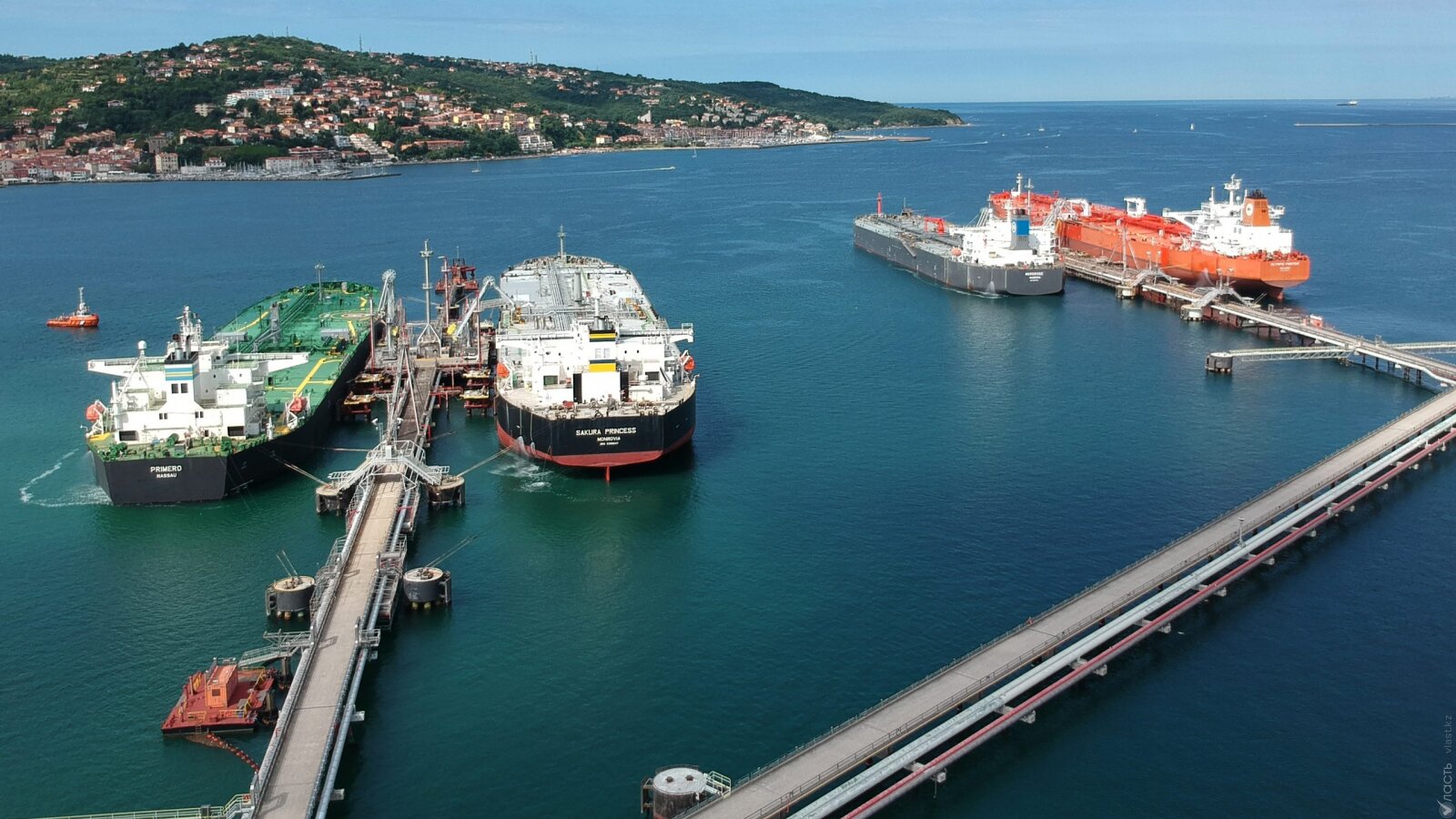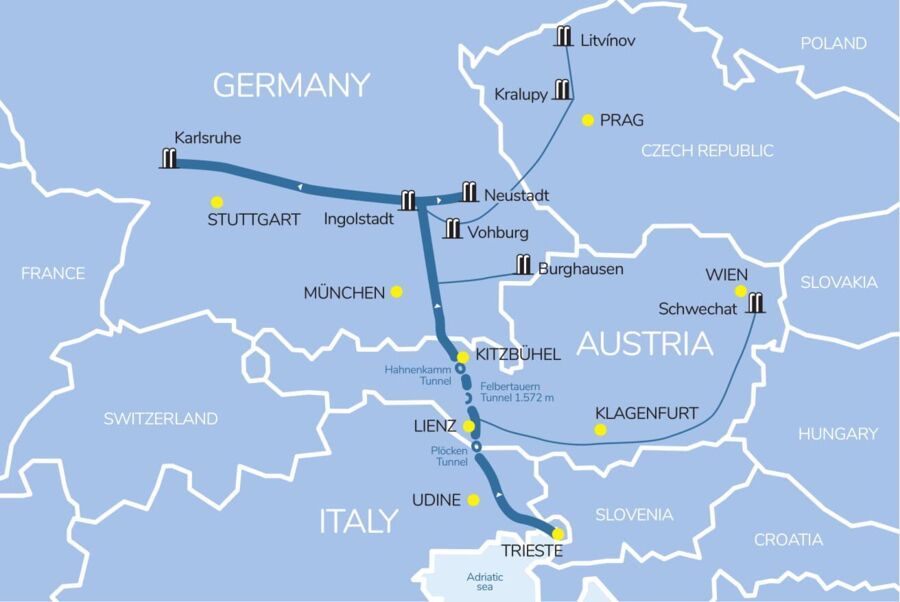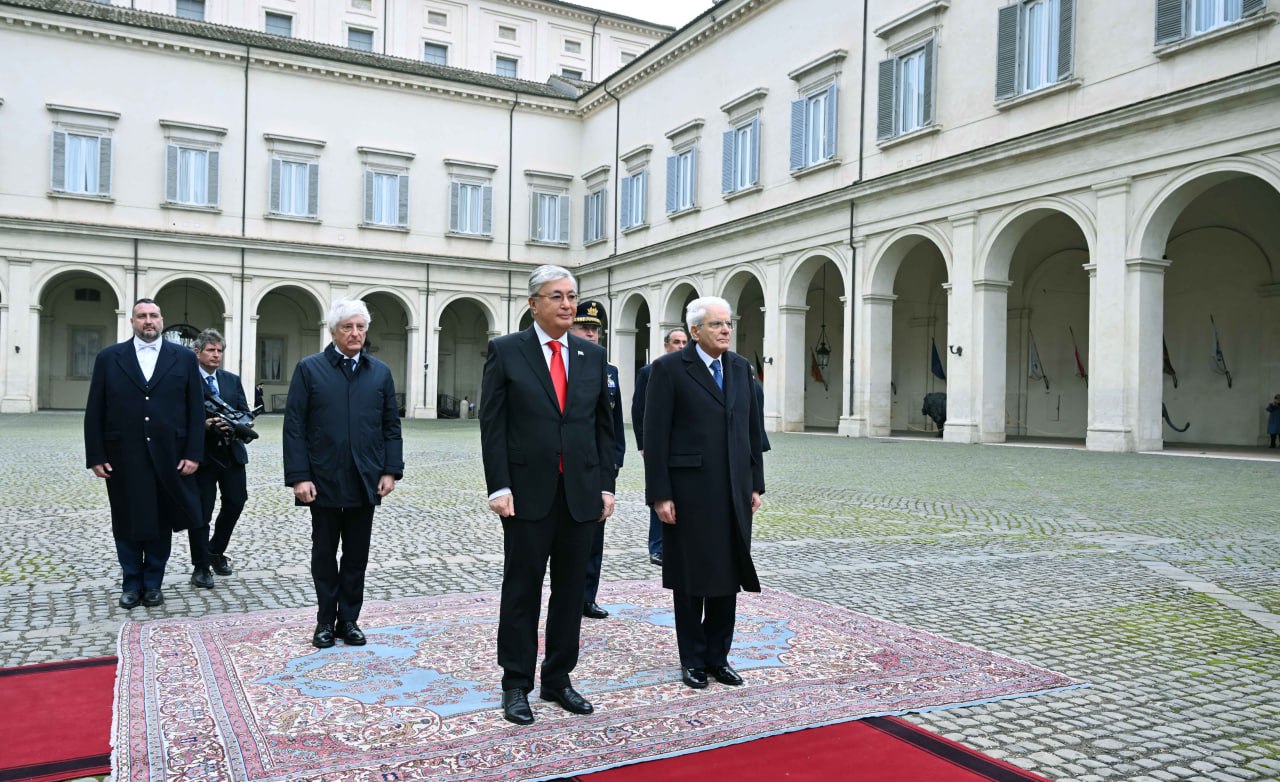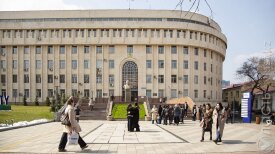Kazakhstan’s President Kassym-Jomart Tokayev flew to Rome on January 18 to meet with the Italian president Sergio Mattarella and prime minister Giorgia Meloni. Citing his public appearances, Kazakhstan’s media repeated what their officials have said for many years: Italy is among the top three strategic trade partners and the main destination for Kazakhstan’s oil exports. But this is in fact, a gross misrepresentation of Italy’s role for European oil flows and somewhat overestimates Kazakhstan-Italy relations.
Tokayev’s trip to Italy comes almost ten years after the last time the two countries’ heads of government paid each other an official visit. In 2015, then-President Nursultan Nazarbayev visited Italy and met with then-prime minister Matteo Renzi. The year before, Renzi had visited Nazarbayev in Kazakhstan.
Importantly, in both 2014 and 2015 Renzi and Nazarbayev signed documents forging further enhanced cooperation between the two countries, especially in the energy sector. Italian investment in Kazakhstan’s oil and gas industry spans more than three decades and Italian companies are involved in two of the three largest fields in the country, Karachaganak and Kashagan.
The often-quoted statement that Italy has Kazakhstan’s number one crude oil customer for more than a decade, however, is misleading and, for some years, wrong.
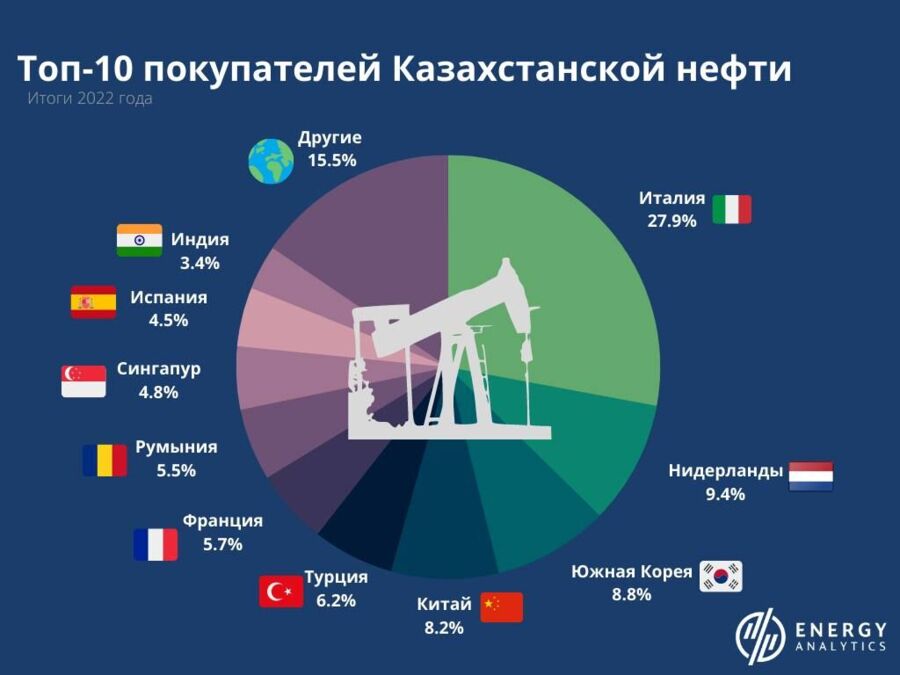
An example of the skewed statistics often published in Kazakhstan’s media. Telegram channel: Energy Analytics.
To Italy, but not ‘Into Italy’
Most of Kazakhstan’s oil exports, around 80%, are pumped via the Caspian Pipeline Consortium (CPC), a large cross-border pipeline that starts in the oil-rich, western Atyrau region in Kazakhstan and skirts around the Caspian Sea towards the Russian Black Sea port of Novorossiysk.
Since its completion in 2001, the CPC has become the main outlet for Kazakhstan’s oil exports, which represent one of the main contributing factors to the country’s GDP.
“CPC’s capacity of 1.4 million barrels a day can be roughly translated into two tankers a day,” Kpler’s Lead Crude Analyst, Viktor Katona, told Vlast in an interview.
Once it gets to Novorossiysk, however, Kazakhstan’s crude takes unpredictable, difficult to trace routes.
From industry data, we know that oil unloaded at Novorossiysk’s marine terminals is transferred onto oil tankers, often owned by oil trading companies, and then shipped across the Black and the Mediterranean Seas, according to the demand of the market. Each load of the same crude can be priced differently, according to intermediary buyers, destination, and market tickers.
The port of Trieste, in north-eastern Italy, is one of the main entry points for Kazakhstan’s crude exports to Europe via the CPC. Industry consultants at Kpler wrote in a brief that “Italy traditionally is the main importer of CPC oil, taking close to a third of shipments bound to Europe.”
Kpler’s Katona, however, warned that this statement should be taken with a grain of salt.
“While you can see massive volumes going to Trieste, none of those should actually count as ‘Italian’. Trieste serves rather as a gateway for customers who do not have access to the sea,” Katona told Vlast in an interview.
A Short Layover in Trieste
Oil unloaded at the CPC marine terminal and directed towards Italy, in most cases reaches the port of Trieste. In 2023, around 76% of CPC’s oil sent to Italian ports landed in Trieste. In 2022, the proportion was 85%, while in 2021 almost 89%, industry data shows.
The port of Trieste, however, is a peculiar one, according to Katona.
“Trieste is interesting because it doesn’t serve any Italian customers. When you see oil coming to Trieste, it technically reaches Italian territory, but it will not be refined in Italy. You need to discount Trieste to get the actual volumes going into Italy” Katona told Vlast.
Once it reaches the port, in fact, CPC oil is immediately funneled into the Trans-Alpine Pipeline (TAL), a 753-kilometer energy infrastructure that links the port of Trieste with refineries in Austria, the Czech Republic, and Germany.
According to its website, TAL fulfills “the oil needs of Austria (90%), Czech Republic (50%) and southern Germany (100%).”
Reached by Vlast, a TAL pipeline spokesperson confirmed that the oil arriving at the port of Trieste is directly loaded into their pipeline system and then shipped to refineries elsewhere in Europe.
“The oil that we receive from Kazakhstan does not ‘enter’ Italy. It is directly pumped via our pipeline to the refineries that our shareholders co-own in Germany, Austria, and the Czech Republic,” the spokesperson said.
“Technically, we should be speaking of Kazakhstan’s deliveries to Germany, Austria, or the Czech Republic,” Katona added.
Trieste is a “free port”, established in 1719 by Karl VI, emperor of Austria. In 1947, within the framework of post-World War II agreements, its “extraterritorial” legal and fiscal status was confirmed.
Although geographically located in Italy, goods and commodities arriving at the Trieste port and earmarked for transfer to other countries do not technically enter Italian soil.
Kazakhstan’s CPC oil arrives at the port of Trieste via tankers operated by TAL shareholders or traders that partner with TAL.
On its website, TAL lists a range of oil companies and traders (OMV, Shell, Rosneft, Eni, C-BLUE B.V. (Gunvor), ExxonMobil, Mero, Phillips 66/Jet Tankstellen, and Total) among the group’s shareholders.
In 2023, Shell, Rosneft, Phillips, and ExxonMobil were shareholders in the Karlsruhe refinery “MiRo” in southern Germany (ExxonMobil agreed to sell its 25% stake in October last year), which is mainly supplied via TAL. The Neustadt and Vohburg refinery complex in southern Germany, also served by TAL, is owned by some of TAL’s shareholders (Swiss-based Varo Energy, Rosneft, and Eni). Cyprus-registered Gunvor, another TAL shareholder, owns the Ingolstadt refinery in southern Germany.
Austria’s OMV owns the Burghausen refinery in Germany and the Schwechat refinery in Austria, both supplied by TAL. The Transalpine Pipeline also pumps oil towards Czech refineries Litvinov and Kralupy, which only recently became the potential target of supplies via the Druzhba pipeline.
Notably some of the main shareholders in TAL (Shell, Eni, ExxonMobil, and Total) also own stakes in the three largest fields in Kazakhstan, which feed their production into the CPC system.
“The volumes that these companies move in the market from Kazakhstan is really a reflection of their shares in those three fields. And they tend to ‘take the oil home’,” Katona said, referring to refineries in which these companies hold stakes.
National oil company Kazmunaigas (KMG) also trades oil that the three major fields produce via the CPC. KMG owns minority stakes in Tengiz, Kashagan, and Karachaganak.
Overestimating Volumes
In the first year since the start of Russia’s military aggression in Ukraine, the port of Trieste showed its best results in terms of processed goods, with a 17% increase in container unloading compared to 2021.
Oil shipments to Trieste have remained stable, according to TAL, which processes crude reaching the port’s oil terminal.
In 2022, TAL pumped through its pipeline system 37 million tons of oil, around 11 million tons of which (or 30%) originated from Kazakhstan. The TAL spokesperson confirmed in a phone call that data for 2023 shipments would fall in line with the previous year.
Kazakhstan’s statistics, which counts shipments to Trieste, reported that total oil exports in 2022 amounted to more than 18 million tons. In fact, only about one-third of that amount reached Italian refineries. Once quantities docking at Trieste and then distributed outside of Italy are discounted, Italy becomes merely one of many among Kazakhstan’s main export destinations. The largest importer of Kazakhstan’s oil in 2022, would have been Germany with 8.5 million tons (fourth behind Russia, Norway, and the US), according to German statistics.
For Italy, Kazakhstan is only the fifth-largest source of oil imports, after Azerbaijan, Libya, Iraq, and the US.
Smaller quantities of Kazakhstani oil reach the Italian ports of Milazzo, Augusta, Genoa, and Ancona, all linked to local refineries. Located near the Augusta port, the ISAB refinery - sold by Russia’s Lukoil to Cyprus-registered GOI Energy in late 2023 - is in fact the one that processes most of Kazakhstan’s real oil exports to Italy.
Friend or Foe
European refineries that were either co-owned by Russia’s Rosneft or Lukoil or their long-standing partners processed a combination of heavy (Urals) and light (CPC) crude oil. Certain refineries in Germany, Katona said, use the CPC blend as a “lightening feedstock to blend with heavier grades that they buy in the market.” CPC is among the cheapest light crude in the market.
Since February 2022 and, more strictly since stringent European sanctions in December 2022, Russia’s Urals became less attractive and riskier for European refineries, which shifted to other oil grades. This made Kazakhstan’s CPC exports less attractive for certain destinations in the Mediterranean, according to a seasoned analyst at an Italian refinery.
“Compared to previous years, we have seen fewer oil tankers carrying oil from Kazakhstan in recent months,” the analyst told Vlast on condition of anonymity.
Katona speculated that this reduction has to do with the waning shipments of Urals grade.
When Kazakhstan and Germany hailed the “new” oil connection via the Soviet-era Druzhba (Russian for ‘Friendship’) pipeline passing through Russia, industry insiders raised their eyebrows.
Despite not being evident in Kazakhstan’s statistics, Germany had in fact bought oil from via the TAL pipeline for decades. What had changed in 2023 was that a previously “toxic” pipeline, pumping a blend of Kazakhstani and Russian oil, was now only being used to ship oil from Kazakhstan, which allowed an exemption from Western sanctions for the pipeline.
The oil sent through Druzhba to the Schwedt refinery in Germany now only originates from Kazakhstan, but experts say it is difficult to distinguish it from the previous blend, which was mixed with Russia’s Urals (a heavier grade than the CPC blend, but similar to other crude from Kazakhstan).
In an effort to mark the distinction between oil from Kazakhstan and Urals, in June 2022, the government proposed a rebranding of its oil into KEBCO (Kazakhstan Export Blend Crude Oil).
The problem is that, according to scientific measures, there is no difference between the two. In late 2022, Marcus How, head of analysis at the political risk advisory firm VE Insights, told Vlast that: “Even Kazakhstan’s oil shipped via pipeline to Samara could be mixed with Russian oil and it will be difficult to detect.”
The publicity over “Germany as Kazakhstan’s new export option” could have been more of an attempt to whitewash Druzhba’s opaque shipments than a genuine excitement towards a new export vector, given the marginal volumes. Compared to CPC’s 54 million tons of oil exported in 2023, Kazakhstan’s oil shipped via Druzhba, marked as KEBCO, was shy of one million tons for the year.
Kazakhstan’s reliance on shipping its export-bound oil through Russia is a structural problem that the government is unlikely to resolve any time soon. The CPC has shown how real or fabricated hindrances at the Russian end can significantly choke such a key outlet for Kazakhstan’s exports. And CPC shipments will continue to be far larger than KEBCO, according to industry analysts, who forecast a maximum annual availability of 12 million tons of oil marked as KEBCO.
When this month local media in Kazakhstan will be flooded with press releases hailing Bulgaria as the “newest customer” for buying around 70,000 tons of KEBCO, it would be wise to remember how unscalable this is and how little this means for Kazakhstan’s state coffers.
Поддержите журналистику, которой доверяют.
